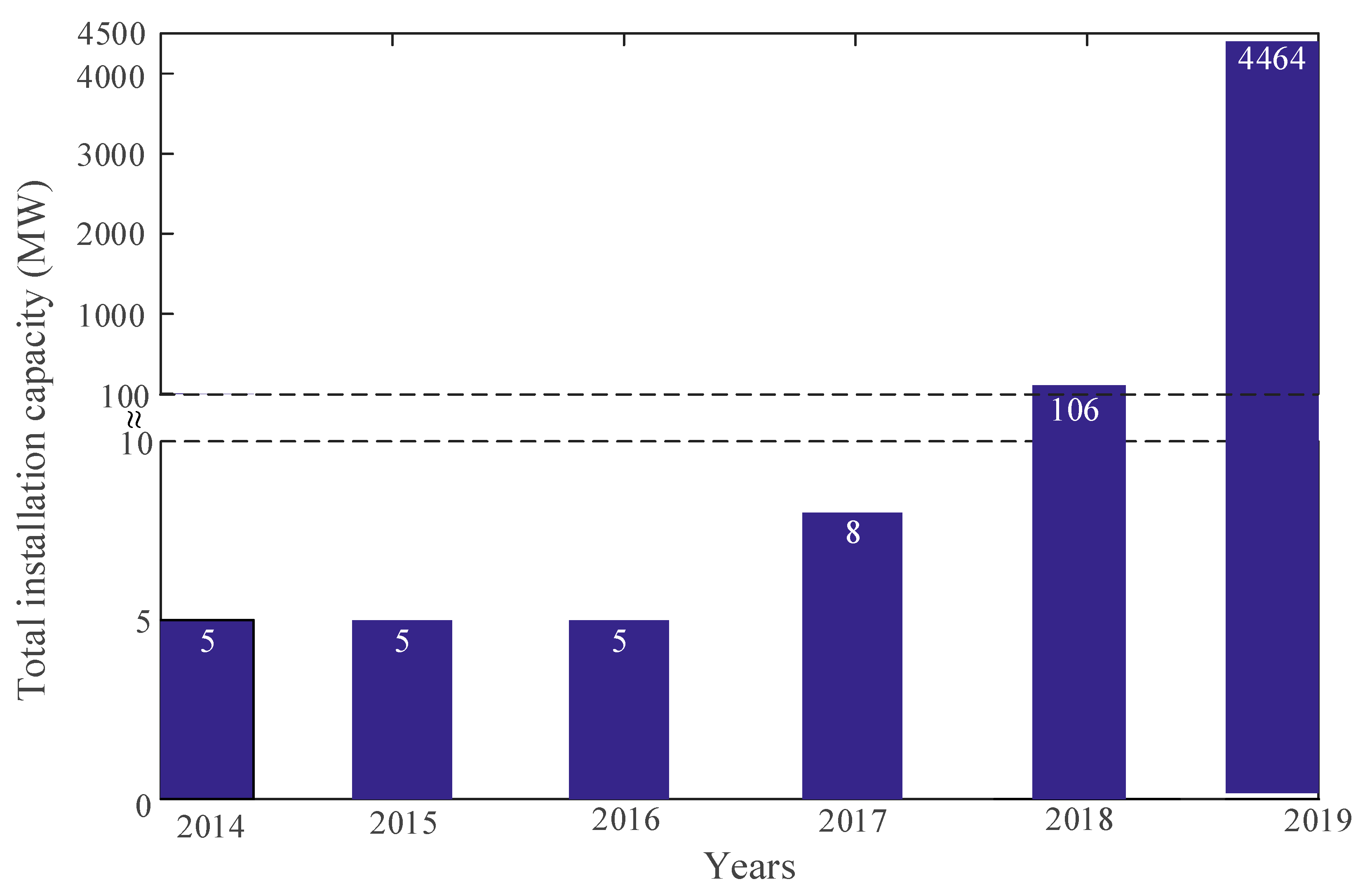A Method to Estimate and Analyze the Performance of a Grid-Connected Photovoltaic Power Plant
Abstract
1. Introduction
1.1. Solar Power Status in Vietnam
1.2. Literature Review
2. System Description
2.1. Simulation Model Description
2.2. Solar PV Power Plants’ Descriptions
3. Methodology
3.1. PV Model
3.2. Performance Model
3.3. Losses of System
3.4. MATLAB/Simulink Development
4. Results and Discussions
4.1. Input Parameters
4.2. Simulation Results
4.3. Performance Analysis of the Dai Nam PV Rooftop PV System and the Buon Ma Thuot Solar Farm
5. Conclusions
Author Contributions
Funding
Acknowledgments
Conflicts of Interest
References
- Polo, J.; Bernardos, A.; Navarro, A.; Fernandez-Peruchena, C.; Ramírez, L.; Guisado, M.V.; Martínez, S. Solar resources and power potential mapping in Vietnam using satellite-derived and GIS-based information. Energy Convers. Manag. 2015, 98, 348–358. [Google Scholar] [CrossRef]
- Mechanism for Solar Power Development in Vietnam; Decision No. 11/2017/QD-TTg; Vietnam Government Office: Hanoi, Vietnam, 2017.
- Waldau, A.J. PV Status Report; Publications Office of the European Union: Luxembourg, 2019. [Google Scholar]
- Report, I. Renewable Energy Statistics. Available online: https://www.irena.org/publications/2019/Jul/Renewable-energy-statistics-2019 (accessed on 22 September 2019).
- IRENA. Renewable Power Generation Costs in 2018; IRENA: Abu Dhabi, United Arab Emirates, 2018. [Google Scholar]
- Nacer, T.; Hamidat, A.; Nadjemi, O.; Bey, M. Feasibility study of grid connected photovoltaic system in family farms for electricity generation in rural areas. Renew. Energy 2016, 96, 305–318. [Google Scholar] [CrossRef]
- Kumar, B.S.; Sudhakar, K. Performance evaluation of 10 MW grid connected solar photovoltaic power plant in India. Energy Rep. 2015, 1, 184–192. [Google Scholar] [CrossRef]
- Mpholo, M.; Nchaba, T.; Monese, M. Yield and performance analysis of the first grid-connected solar farm at Moshoeshoe I International Airport, Lesotho. Renew. Energy 2015, 81, 845–852. [Google Scholar] [CrossRef]
- Martín-Martínez, S.; Cañas-Carretón, M.; Honrubia-Escribano, A.; Gómez-Lázaro, E. Performance evaluation of large solar photovoltaic power plants in Spain. Energy Convers. Manag. 2019, 183, 515–528. [Google Scholar] [CrossRef]
- Sidi, C.E.B.E.; Ndiaye, M.L.; El Bah, M.; Mbodji, A.; Ndiaye, A.; Ndiaye, P.A. Performance analysis of the first large-scale (15 MWp) grid-connected photovoltaic plant in Mauritania. Energy Convers. Manag. 2016, 119, 411–421. [Google Scholar] [CrossRef]
- Baghdadi, I.; El Yaakoubi, A.; Attari, K.; Leemrani, Z.; Asselman, A. Performance investigation of a PV system connected to the grid. Procedia Manuf. 2018, 22, 667–674. [Google Scholar] [CrossRef]
- Shah, K.K.; Mundada, A.S.; Pearce, J.M. Performance of US hybrid distributed energy systems: Solar photovoltaic, battery and combined heat and power. Energy Convers. Manag. 2015, 105, 71–80. [Google Scholar] [CrossRef]
- Good, C.; Andresen, I.; Hestnes, A.G. Solar energy for net zero energy buildings–A comparison between solar thermal, PV and photovoltaic–thermal (PV/T) systems. Sol. Energy 2015, 122, 986–996. [Google Scholar] [CrossRef]
- Cavalcante, F.F.; dos Santos Rodrigues, V.; dos Santos Rodrigues, G.; Nunes, M.V.A.; de Carvalho, E.N.; de Araújo, W.G.; Ramkeerat, P.F.R.; Souza, V. Simulation Study to Evaluate the Performance of a Photovoltaic System Connected to the Electrical Network in the Municipality of Terra Santa–PA. J. Eng. Technol. Ind. Appl. 2017, 3, 133–141. [Google Scholar]
- Jordan, D.C.; Kurtz, S.R. Photovoltaic degradation rates—An analytical review. Prog. Photovolt. Res. Appl. 2013, 21, 12–29. [Google Scholar] [CrossRef]
- Ya’acob, M.E.; Hizam, H.; Khatib, T.; Radzi, M.A.M. A comparative study of three types of grid connected photovoltaic systems based on actual performance. Energy Convers. Manag. 2014, 78, 8–13. [Google Scholar] [CrossRef]
- Sidrach-de-Cardona, M.; Lopez, L.M. Evaluation of a grid-connected photovoltaic system in southern Spain. Renew. Energy 1998, 15, 527–530. [Google Scholar] [CrossRef]
- Van Dyk, E.; Meyer, E.; Vorster, F.; Leitch, A. Long-term monitoring of photovoltaic devices. Renew. Energy 2002, 25, 183–197. [Google Scholar] [CrossRef]
- Pietruszko, S.; Gradzki, M. Performance of a grid connected small PV system in Poland. Appl. Energy 2003, 74, 177–184. [Google Scholar] [CrossRef]
- Mondol, J.D.; Yohanis, Y.; Smyth, M.; Norton, B. Long term performance analysis of a grid connected photovoltaic system in Northern Ireland. Energy Convers. Manag. 2006, 47, 2925–2947. [Google Scholar] [CrossRef]
- Chokmaviroj, S.; Wattanapong, R.; Suchart, Y. Performance of a 500 kWP grid connected photovoltaic system at Mae Hong Son Province, Thailand. Renew. Energy 2006, 31, 19–28. [Google Scholar] [CrossRef]
- Mathieu, H. The impact of angular dependent loss measument of PV module Energy Prediction. In Proceedings of the 29th European PV solar Energy Conference and Exhibition, Amsterdam, The Netherlands, 22–26 September 2014; pp. 22–26. [Google Scholar]
- Kumar, N.M.; Gupta, R.P.; Mathew, M.; Jayakumar, A.; Singh, N.K. Performance, energy loss, and degradation prediction of roof-integrated crystalline solar PV system installed in Northern India. Case Stud. Therm. Eng. 2019, 13, 100409. [Google Scholar] [CrossRef]
- Krauss, K.; Fertig, F.; Menzel, D.; Rein, S. Light-induced degradation of silicon solar cells with aluminiumoxide passivated rear side. Energy Procedia 2015, 77, 599–606. [Google Scholar] [CrossRef]
- Canadian Datasheet. Available online: https://www.canadiansolar.com (accessed on 12 September 2019).
- Seraphin Data Sheet. Available online: http://www.seraphimusa.com/datasheets (accessed on 12 September 2019).
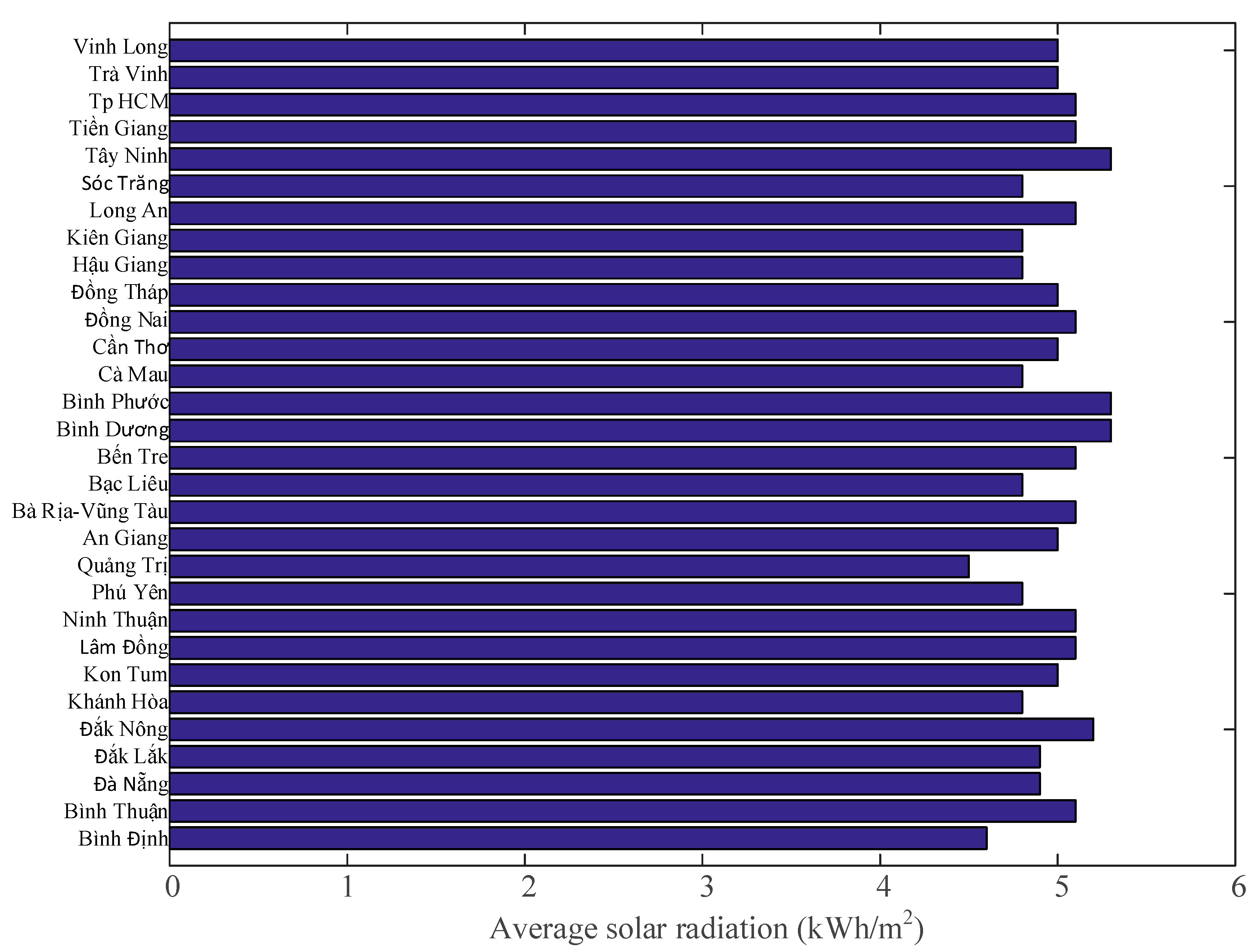
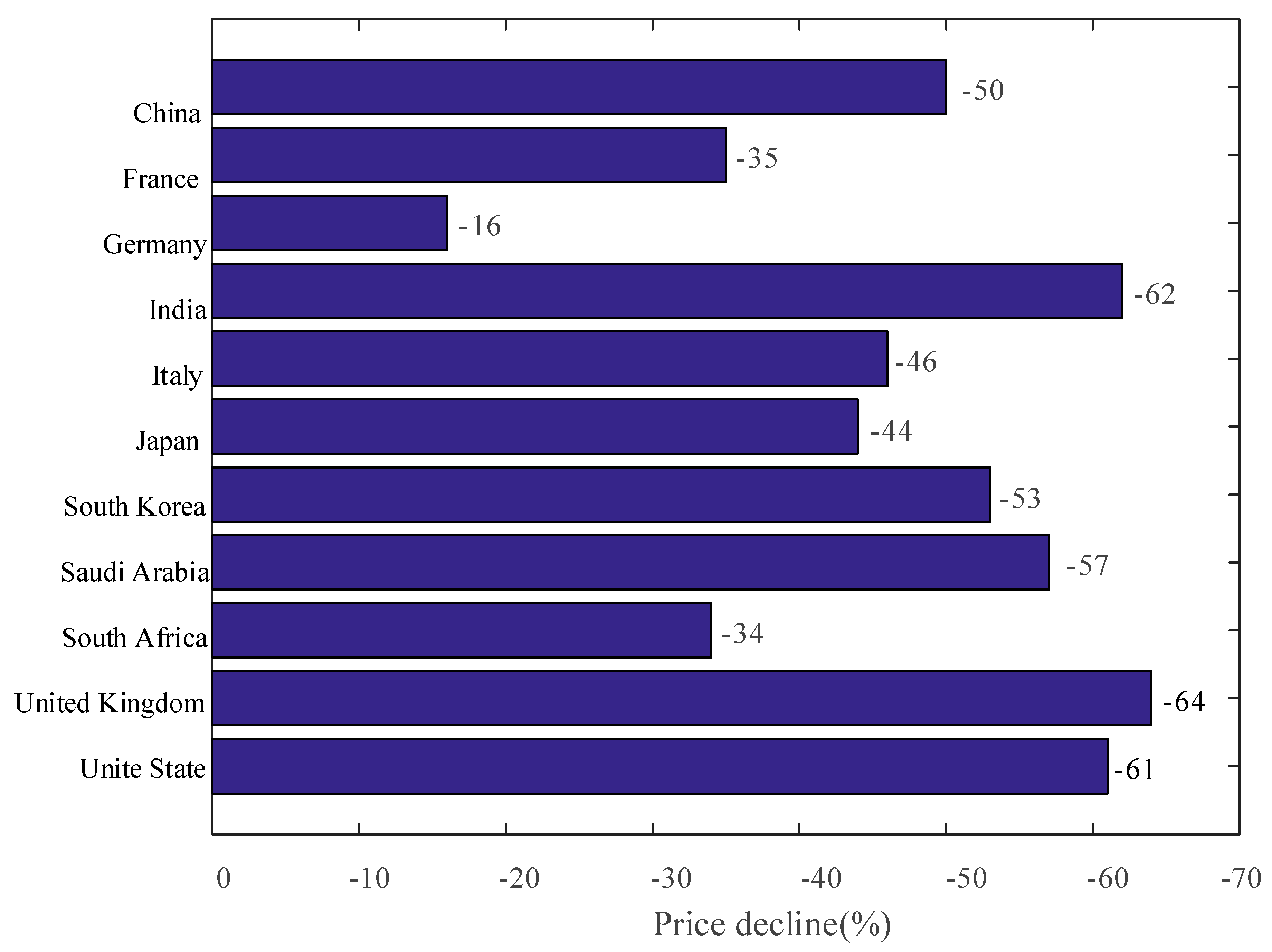
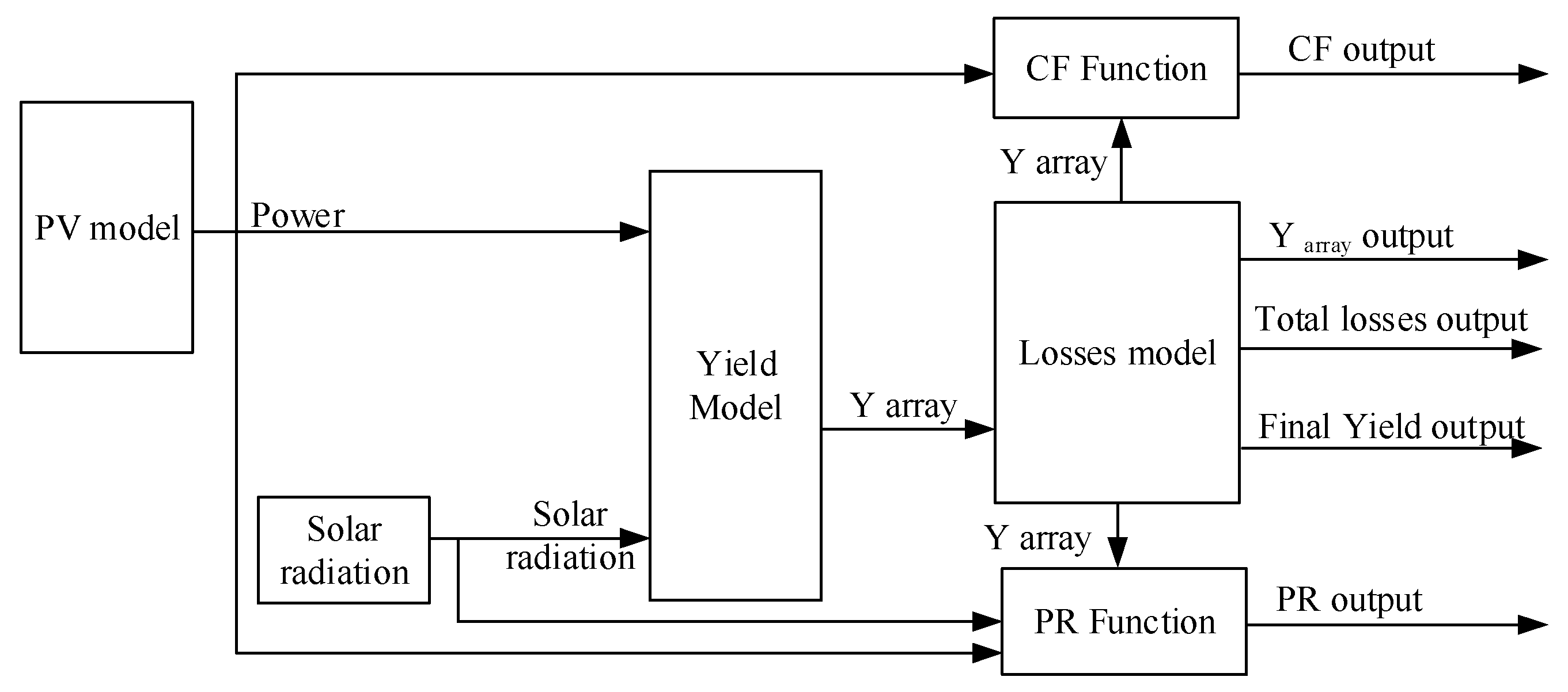
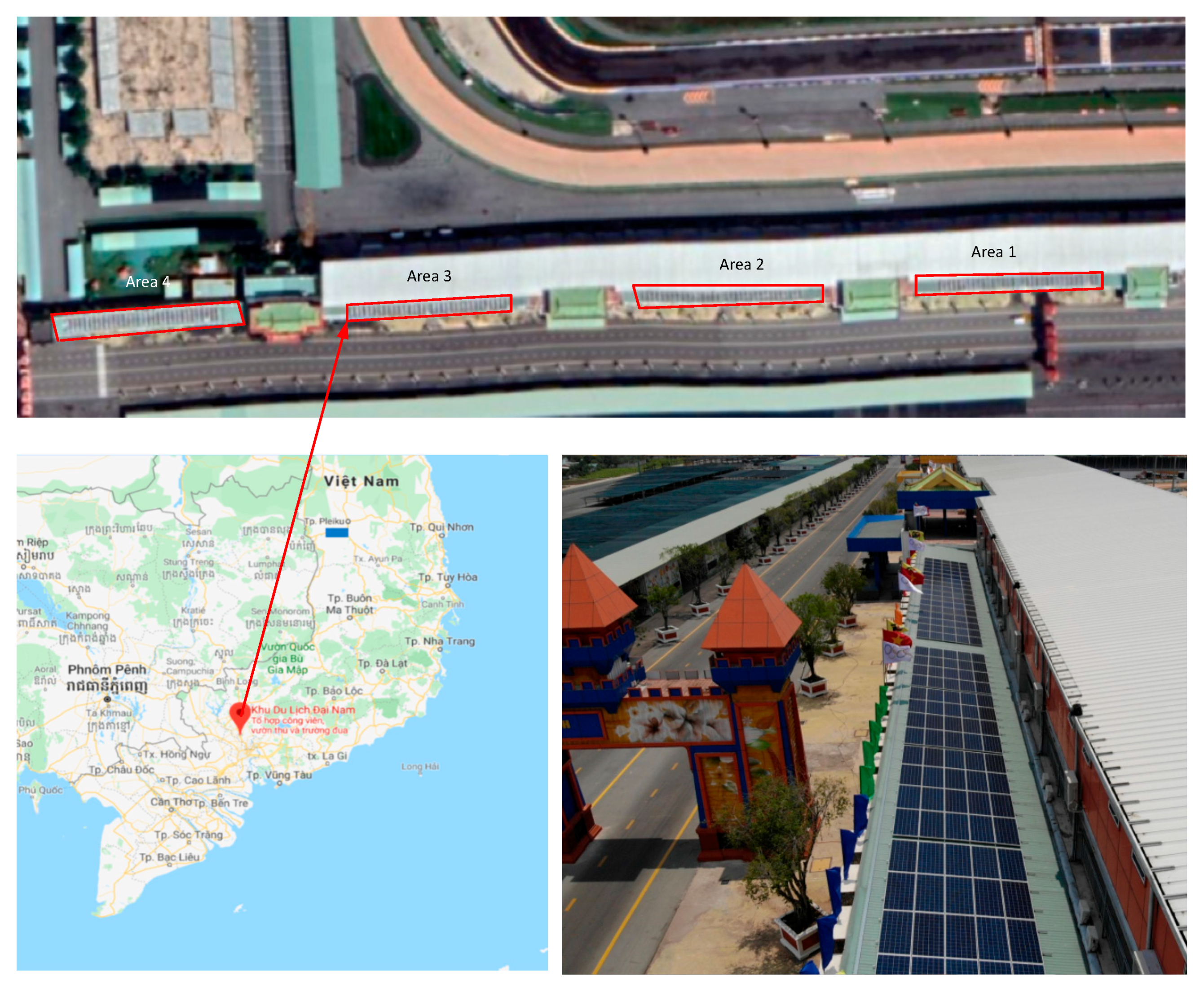
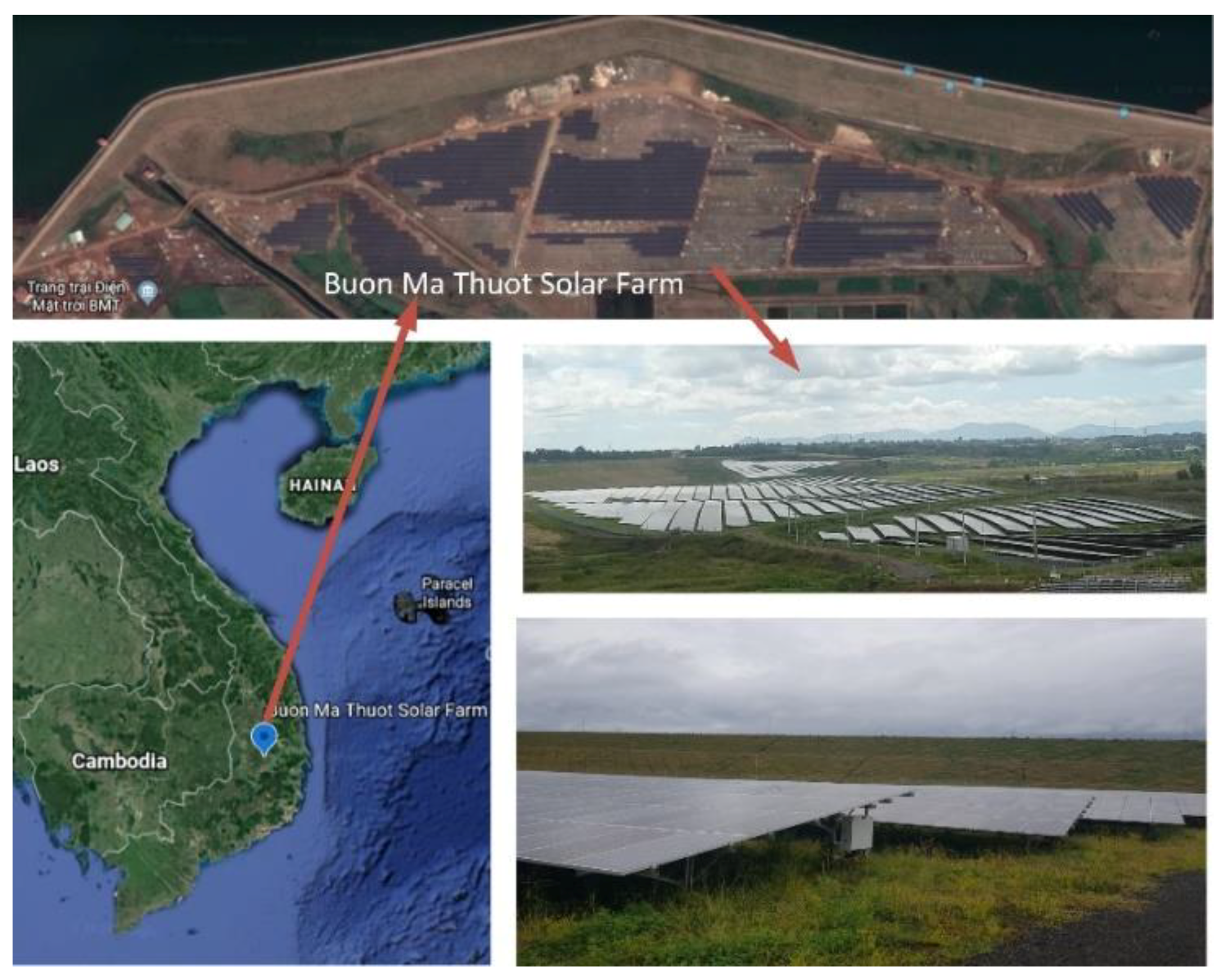
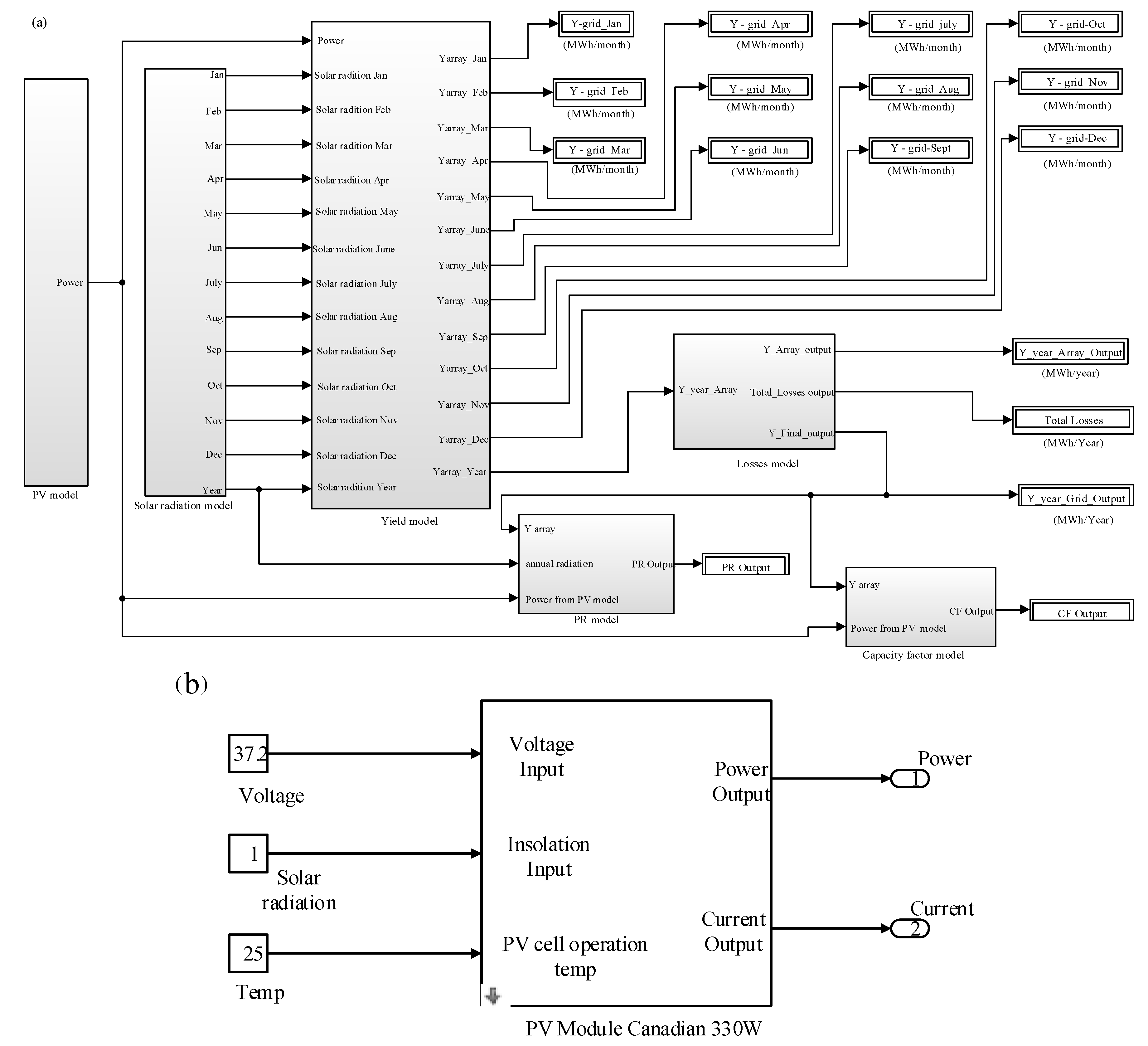
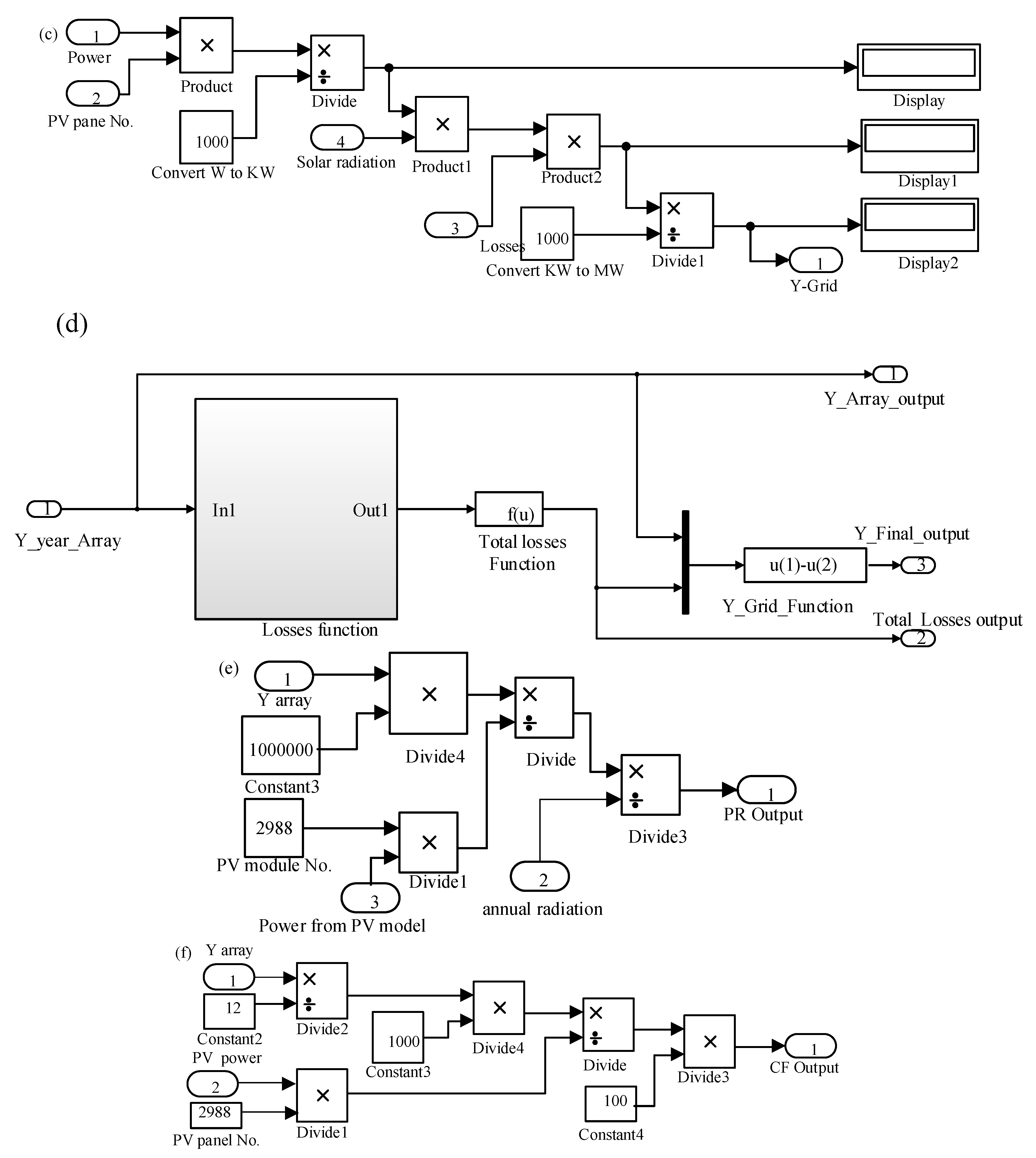
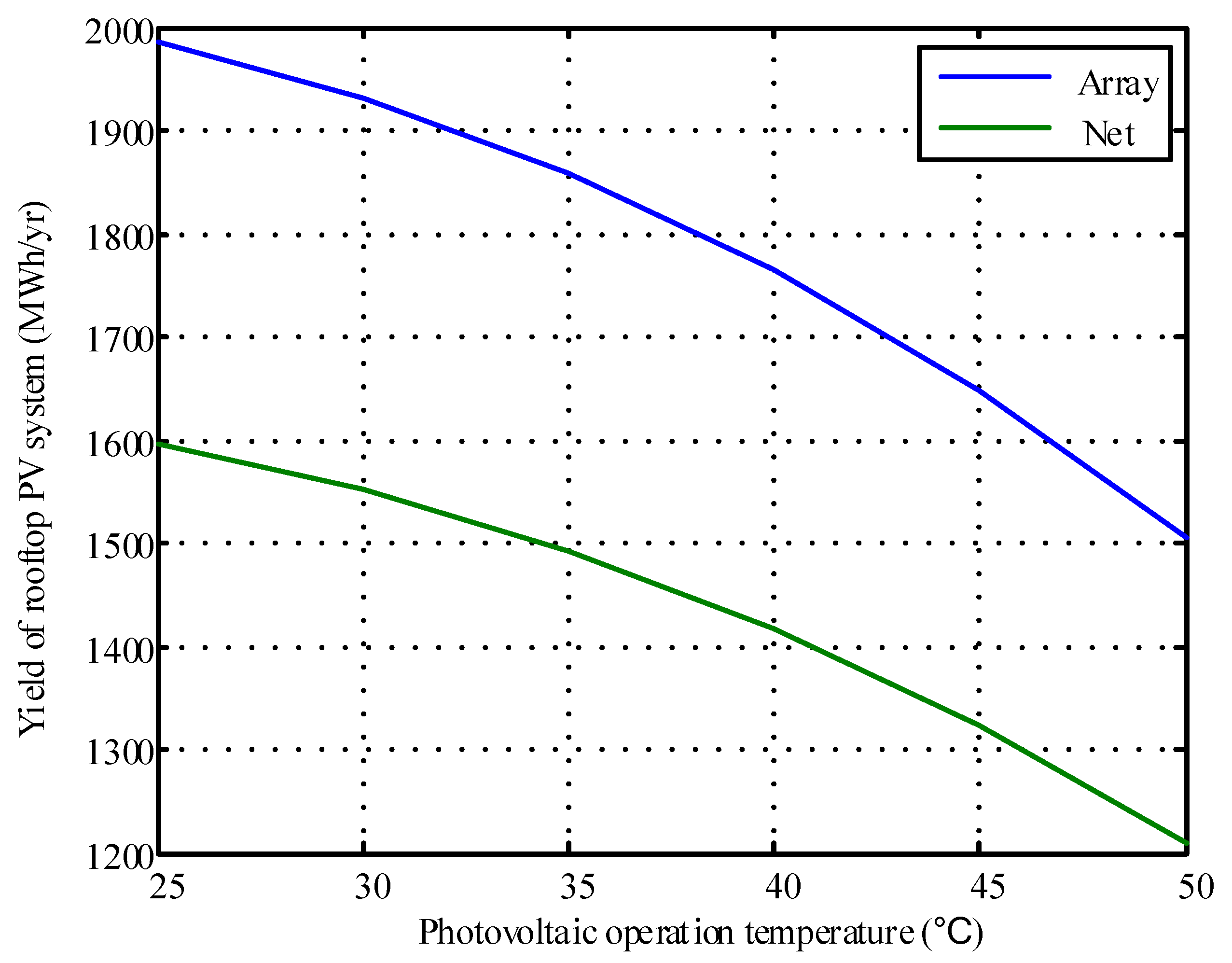
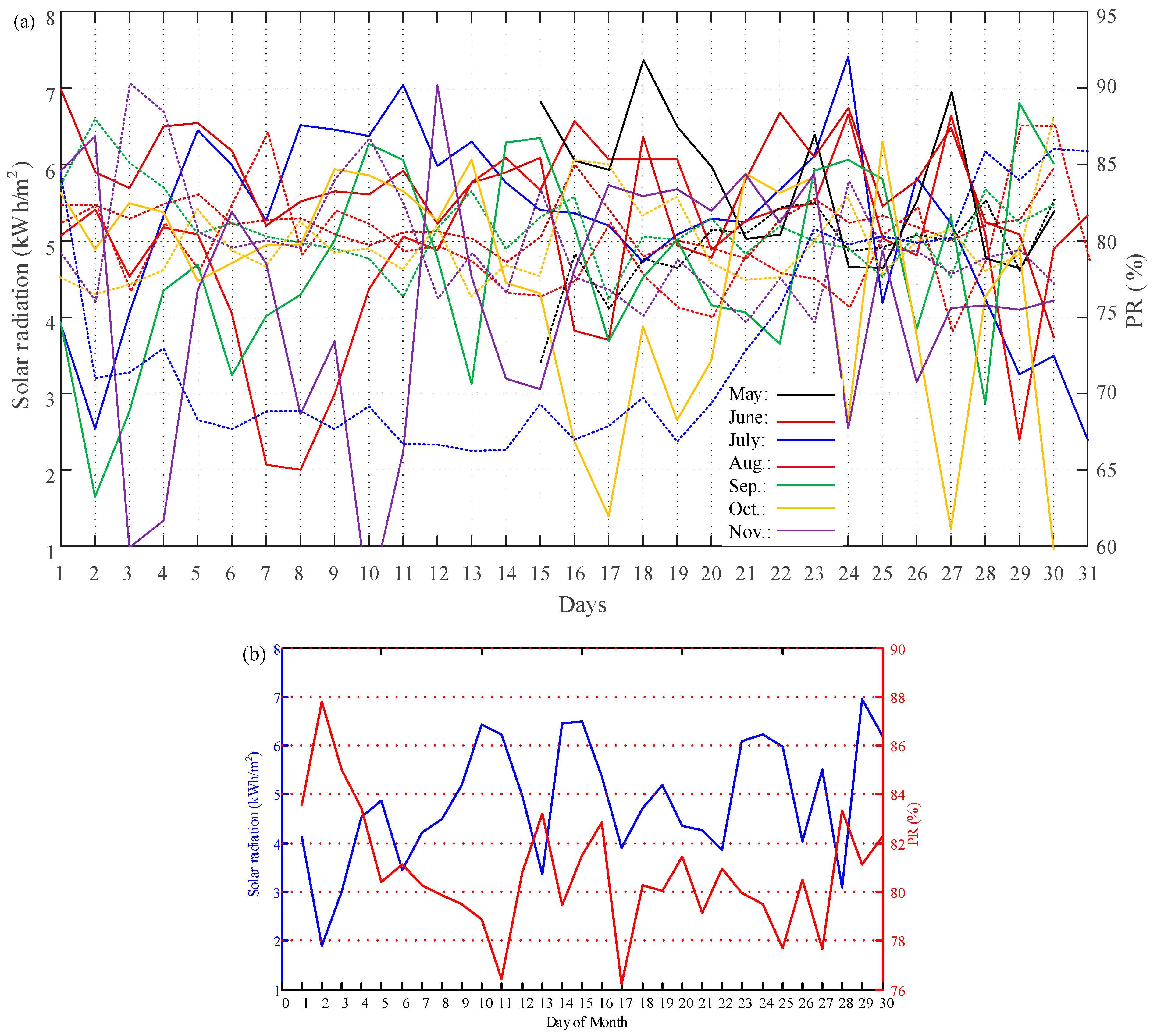
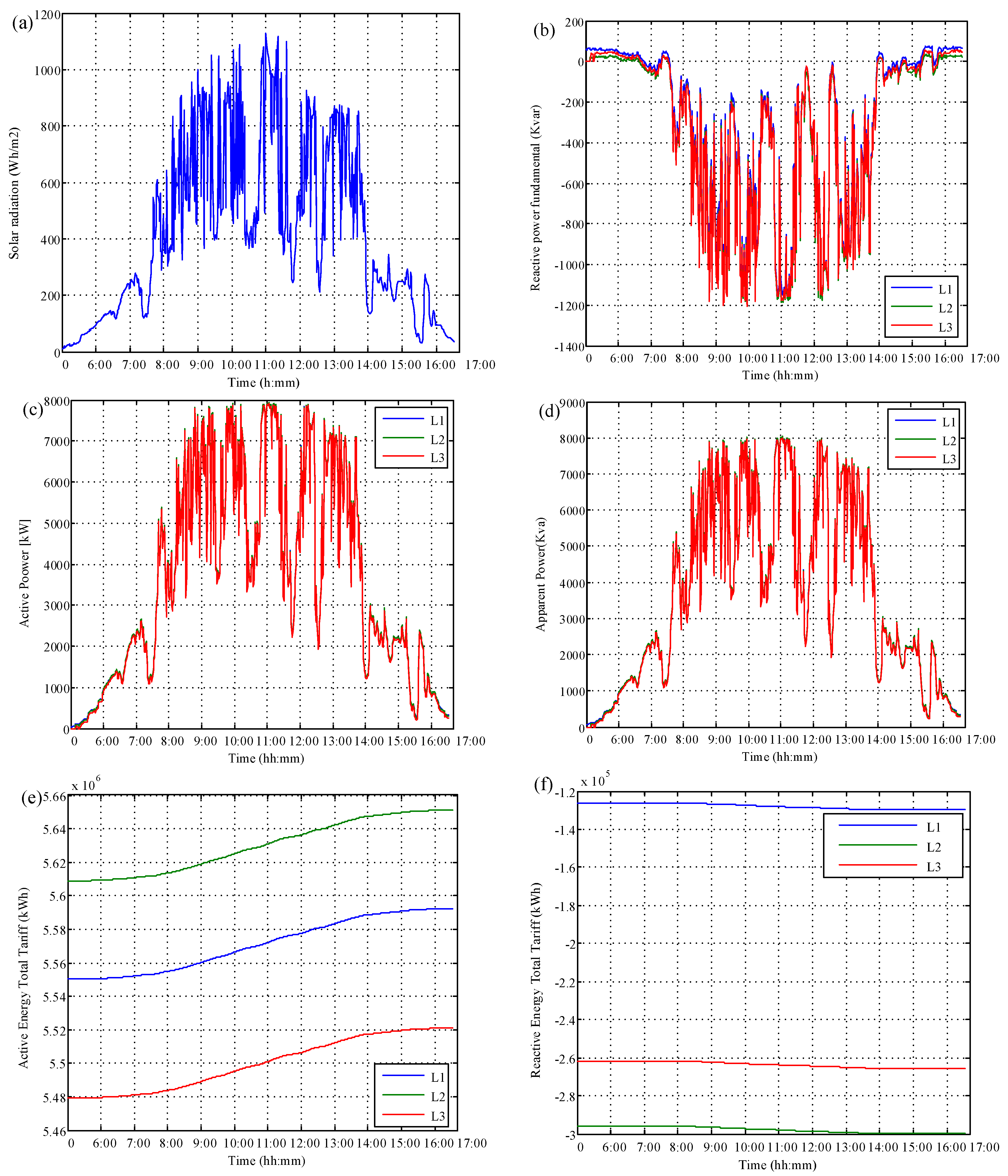
| Areas | Sunshine Hours per Year (hr/yr) | Solar Radiation (kWh/m2/day) |
|---|---|---|
| North East | 1600–1750 | 3.3–4.1 |
| North West | 1750–1800 | 4.1–4.9 |
| Middle North | 1700–2000 | 4.6–5.2 |
| South central region | 2000–2600 | 4.9–5.7 |
| South | 2000–2500 | 4.3–4.9 |
| Average | 1700–2500 | 4.6 |
| Location | Method | Type of PV System | Installed Capacity (KWp) | Final Yield (MWh/yr) | PR (%) |
|---|---|---|---|---|---|
| Algeria [6] | Simulation | Rooftop | 6.24 | 8.6 | − |
| India [7] | Measurement | Rooftop | 10 | 15.79 | 86 |
| Lesotho, South Africa [8] | Measurement | Rooftop | 281 | 125.1 | 67 |
| Spain [9] | Measurement | Solar Farm | 1000 | − | 84 |
| Mauritania, Northwest Africa [10] | Measurements | Solar Farm | 15,000 | 2755 to 4831 | 67.9 |
| This study | Simulation/Measurement | Rooftop/Solar Farm | 1000/30,000 | 78 |
| Simulation Tool | Function | Reference |
|---|---|---|
| PVSyst | Evaluation of technical feasibility | Baghdadi et al. [11] |
| Homer | Evaluation of technical feasibility | Shah et al. [12] |
| Polysun | Design and performance analysis | Good et al. [13] |
| PV Sol | Cavalcante et al. [14] | |
| MATLAB/Simulink | Yield and performance analysis | This study |
| Areas | Installed Capacity(kW) | Number of Solar Panel | Number of Inverter |
|---|---|---|---|
| Area 1 | 448.8 | 1360 | 7 × 60 kW |
| Area 2 | 227.04 | 688 | 2 × 60 kW + 2 × 50 kW |
| Area 3 | 211.2 | 640 | 4 × 60 kW |
| Area 4 | 99 | 300 | 2 × 50 kW |
| Items | Specification |
|---|---|
| Longitude and latitude | 12°46′48″ N 108°21′35″ E |
| Installed capacity | 30.7 MW |
| Number of solar panels | 86,956 (× 345 Wp) |
| Number of inverters | 7 (× 3.5 MW) |
| Characteristics | Specifications of Canadian CS1H330 | Specifications Seraphim SRP-345-6MA |
|---|---|---|
| Maximum power rating (W) | 330 | 345 |
| Maximum power voltage (V) | 37.2 | 37.90 |
| Maximum power current (A) | 8.88 | 9.11 |
| Short circuit current (A) | 9.65 | 9.43 |
| Module efficient (%) | 19.57 | 17.78 |
| Temperature coefficient of short circuit (%/°C) | 0.05 | 0.05 |
| Month | Dai Nam | Buon Ma Thuot |
|---|---|---|
| January | 5.39 | − |
| February | 6.31 | − |
| March | 6.69 | − |
| April | 6.74 | − |
| May | 5.69 | 99.70 |
| Jun | 5.38 | 171.4 |
| July | 5.35 | 161.8 |
| August | 5.31 | 156.13 |
| September | 5.23 | 145.36 |
| October | 5.14 | 157.67 |
| November | 4.99 | 124.91 |
| December | 4.88 | − |
| Yearly average | 5.59 | − |
| (a) Monthly Yield of Rooftop PV System for Difference Temperature (in MWh) | ||||||
|---|---|---|---|---|---|---|
| Month | 25 °C | 30 °C | 35 °C | 40 °C | 45 °C | 50 °C |
| January | 127.13 | 123.62 | 118.19 | 112.92 | 105.41 | 96.37 |
| February | 139.5 | 135.66 | 130.53 | 123.91 | 115.68 | 105.75 |
| March | 147.9 | 143.83 | 138.39 | 131.38 | 122.65 | 112.12 |
| April | 159.5 | 155.10 | 149.23 | 141.67 | 132.26 | 120.91 |
| May | 134.79 | 131.07 | 126.11 | 119.72 | 111.76 | 102.17 |
| Jun | 127.45 | 123.93 | 119.24 | 113.20 | 105.67 | 96.61 |
| July | 126.74 | 123.24 | 118.57 | 112.57 | 105.09 | 96.07 |
| August | 125.79 | 122.32 | 117.69 | 111.72 | 104.30 | 95.35 |
| September | 123.89 | 120.47 | 115.91 | 110.04 | 102.73 | 93.91 |
| October | 121.76 | 118.40 | 113.92 | 108.15 | 100.96 | 92.30 |
| November | 118.21 | 114.94 | 110.60 | 104.99 | 98.02 | 89.60 |
| December | 115.60 | 112.41 | 108.16 | 102.68 | 95.85 | 87.63 |
| (b) The performance results of yearly results | ||||||
| Temperature (°C) | Array Yield (MW) | Grid Yield (MW) | Total Loss (MW) | Total Loss (MW) | CF | |
| 25 | 1986.40 | 1595.08 | 391.30 | 80 | 13.46 | |
| 30 | 1931.56 | 1551.04 | 380.50 | - | - | |
| 35 | 1858.47 | 1492.35 | 366.12 | - | - | |
| 40 | 1764.31 | 1416.74 | 347.57 | - | - | |
| 45 | 1647.07 | 1322.60 | 324.47 | - | - | |
| 50 | 1505.75 | 1209.12 | 296.63 | - | - | |
| Month | Simulation (MWh) | Measurement (MWh) | Gap (MWh) | Gap (%) |
|---|---|---|---|---|
| May | 119.72/2419.4 | 122.780/2395 | −3.06/24.4 | 2.5/1.01 |
| June | 113.20/4159.36 | 114.290/4122.58 | −1.09/36.78 | 0.95/0.89 |
| July | 112.57/3628 | 114.010/3505 | −1.44/123 | 1.2/3.5 |
| August | 111.72/3788.8 | 107.610/3747.8 | 4.11/41 | 3.8/1.09 |
| September | 110.04/3527.45 | 95.470/3421.4 | 14.57/106.05 | 15.2/3.09 |
| October | 114.9/3826 | 120.850/3794.6 | −5.95.31.4 | 4.9/0.82 |
| Month | Yield (MW) | PR% | CF% |
|---|---|---|---|
| May | 122,780.0 | 71 | 16.48253 |
| June | 114,290.0 | 71 | 15.85694 |
| July | 114,010.0 | 69 | 15.81389 |
| August | 107,610.0 | 67 | 15.81389 |
| September | 95,470.0 | 63 | 14.92639 |
| October | 120,850.0 | 73 | 13.24167 |
| Month | Final Yield (MW) | PR% |
|---|---|---|
| May * | 2395 | 79.4 |
| June | 4122 | 81.42 |
| July | 3565 | 73.76 |
| August | 3747 | 79.66 |
| September | 3421.4 | 80.80 |
| October | 3794.6 | 87.92 |
| November | 2984 | 80.2 |
| Parameters | Value | Unit |
|---|---|---|
| Daily peak AC power (entire plant) | 23.31 | MW |
| Energy output (inverter) | 148.231 | MWh |
| Energy output (main switchgear in MCB) | 147.705 | MWh |
| Energy loss (up to main switchgear) | 0.355 | % |
| Plant energy delivered to the EVN grid | 146.539 | MWh |
| Energy loss (up to the side of transformer) | 0.735 | % |
| E consumed (self-consumed energy) | 0.08 | MWh |
| Energy loss (self-consumption) | 0.054 | % |
| Net power plant energy production | 146.619 | MWh |
| Energy consumption @ night | 0.545 | MWh |
| Energy accumulated this month | 1970.477 | MWh |
| Energy accumulated this year | 15,064.85 | MWh |
| PR | 87.48 | % |
© 2020 by the authors. Licensee MDPI, Basel, Switzerland. This article is an open access article distributed under the terms and conditions of the Creative Commons Attribution (CC BY) license (http://creativecommons.org/licenses/by/4.0/).
Share and Cite
Phuong Truong, L.; An Quoc, H.; Tsai, H.-L.; Van Dung, D. A Method to Estimate and Analyze the Performance of a Grid-Connected Photovoltaic Power Plant. Energies 2020, 13, 2583. https://doi.org/10.3390/en13102583
Phuong Truong L, An Quoc H, Tsai H-L, Van Dung D. A Method to Estimate and Analyze the Performance of a Grid-Connected Photovoltaic Power Plant. Energies. 2020; 13(10):2583. https://doi.org/10.3390/en13102583
Chicago/Turabian StylePhuong Truong, Le, Hoang An Quoc, Huan-Liang Tsai, and Do Van Dung. 2020. "A Method to Estimate and Analyze the Performance of a Grid-Connected Photovoltaic Power Plant" Energies 13, no. 10: 2583. https://doi.org/10.3390/en13102583
APA StylePhuong Truong, L., An Quoc, H., Tsai, H.-L., & Van Dung, D. (2020). A Method to Estimate and Analyze the Performance of a Grid-Connected Photovoltaic Power Plant. Energies, 13(10), 2583. https://doi.org/10.3390/en13102583




